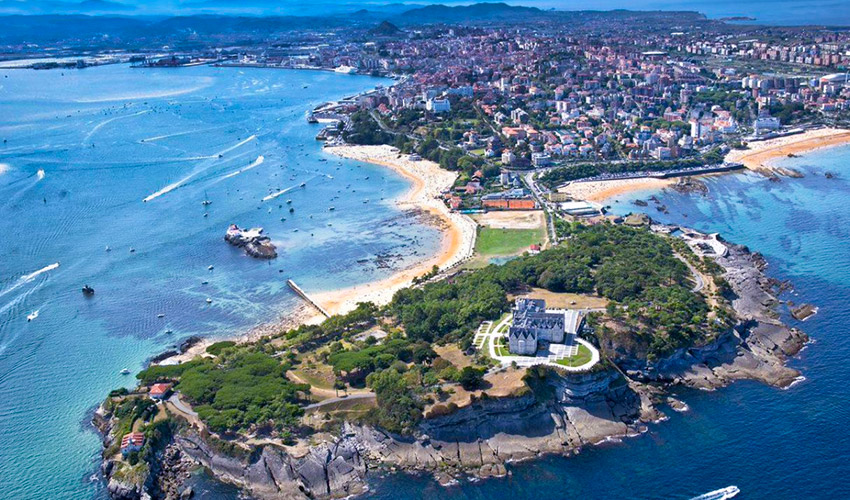Santander

A city that seems straight out of a storybook and whose life revolves around the bay, recognised as one of the prettiest in the world.
Santander (Cantabria), in the north of Spain, is a combination of green mountain landscapes with white sand beaches, elegant mansions and palatial architecture with avant-garde buildings and the unmistakeable echo of its seafaring past. Many cities within a city, perfect for discovering.
There are also items from the Roman era, mostly from Julióbriga and Castro Urdiales, the ancient Flavióbriga. Of note in the medieval collection is the ivory belt buckle from the Santa María de Hito archaeological site.
Opened in 2017, this work by Piano, in partnership with Spanish architect Luis Vidal, is expected to become an architectural and cultural symbol of the city. The construction recalls a stone breakwater, in two volumes over slender columns, as tall as the trees surrounding them, and partly suspended over the sea, designed to harmonise with the setting.Two galleries, lecture rooms, work spaces, a roof terrace where the public can enjoy a unique view of Santander and its bay, and a 300-seater auditorium which also offers an impressive view, with the sea and the mountains forming the backdrop. Location: in central Santander, next to the seafront promenade.Location: in central Santander, next to the seafront promenade.
Santander (Cantabria), in the north of Spain, is a combination of green mountain landscapes with white sand beaches, elegant mansions and palatial architecture with avant-garde buildings and the unmistakeable echo of its seafaring past. Many cities within a city, perfect for discovering.
City of monarchs and fishermen
Santander was the destination par excellence for royalty at the end of the 19th and early 20th centuries. A stroll through the old quarters, with its majestic buildings, transports us to this distinguished past, the greatest witness of which is undoubtedly the Magdalena Palace, the jewel in the city’s crown. This iconic building, located in the highest part of the peninsula of the same name, is one of the essential sights of Santander, allowing you to observe (and photograph) an impressive panoramic view of “the bride of the sea”, as the city is affectionately known, framed by the beach and mountains.Santander fuses this palatial magic with a fishing tradition, which today can be enjoyed especially in the area known as the city’s fishing district: the perfect place to try the most traditional local cuisine, so closely linked to the sea, with dishes such as rabas (fried squid), maganos (squid with onion) or fisherman-style clams.This identity of contrasts is completed with the “new” Santander, the part that has embraced the latest cultural and artistic trends, which is evident in places such as the Botín Centre, designed by the architect and Pritzker Architecture prize winner, Renzo Piano.A family occasion
Santander is a perfect city for a family holiday, as apart from its sights and culinary attractions, it also has activities children will love, such as boat trips around the bay, the La Magdalena mini zoo or the Maritime Museum. Enjoying a day of sunshine on one of Santander’s beaches is another essential plan: don’t miss the ones at El Sardinero, El Camello, Mataleñas, La Concha and Los Peligros.Prehistory and Archaeology Museum of Cantabria
Flavióbriga.
Most of the 1,200 objects on display in this museum date from the period between the Upper Palaeolithic and the Iron Age.There are also items from the Roman era, mostly from Julióbriga and Castro Urdiales, the ancient Flavióbriga. Of note in the medieval collection is the ivory belt buckle from the Santa María de Hito archaeological site.
Centro Botín
A cultural space dedicated to contemporary art, music, film, theatre, and literature. The building, designed by the Pritzker Prize-winning architect Renzo Piano, is set in the Pereda Gardens in an exceptional location on the Santander Bay.Opened in 2017, this work by Piano, in partnership with Spanish architect Luis Vidal, is expected to become an architectural and cultural symbol of the city. The construction recalls a stone breakwater, in two volumes over slender columns, as tall as the trees surrounding them, and partly suspended over the sea, designed to harmonise with the setting.Two galleries, lecture rooms, work spaces, a roof terrace where the public can enjoy a unique view of Santander and its bay, and a 300-seater auditorium which also offers an impressive view, with the sea and the mountains forming the backdrop. Location: in central Santander, next to the seafront promenade.Location: in central Santander, next to the seafront promenade.

 Spanish
Spanish German
German Dutch
Dutch